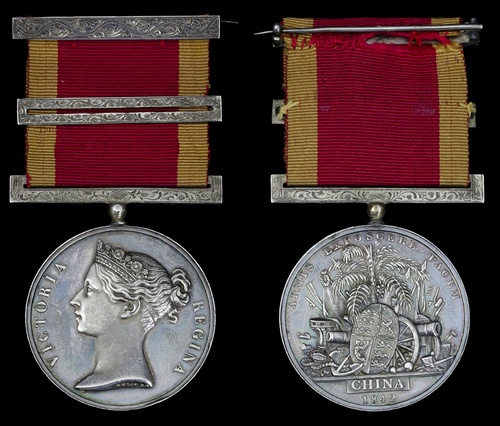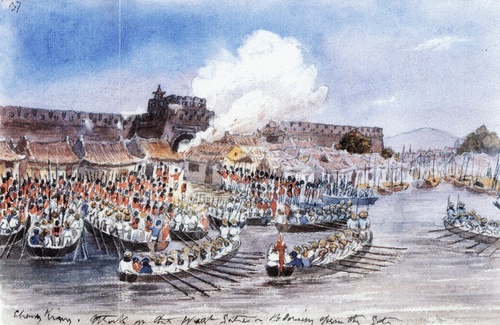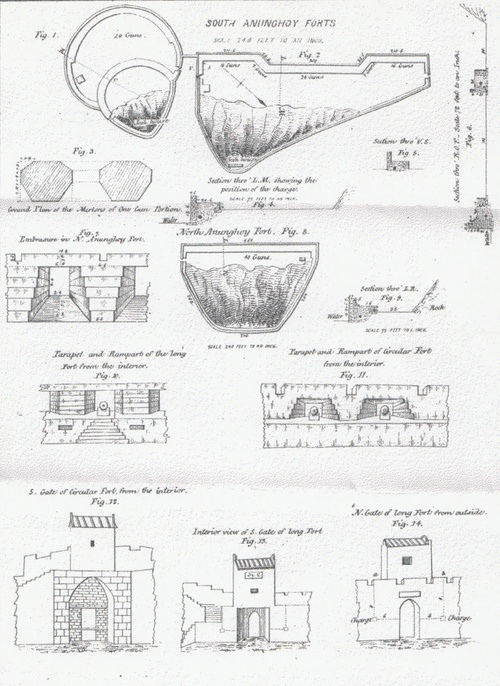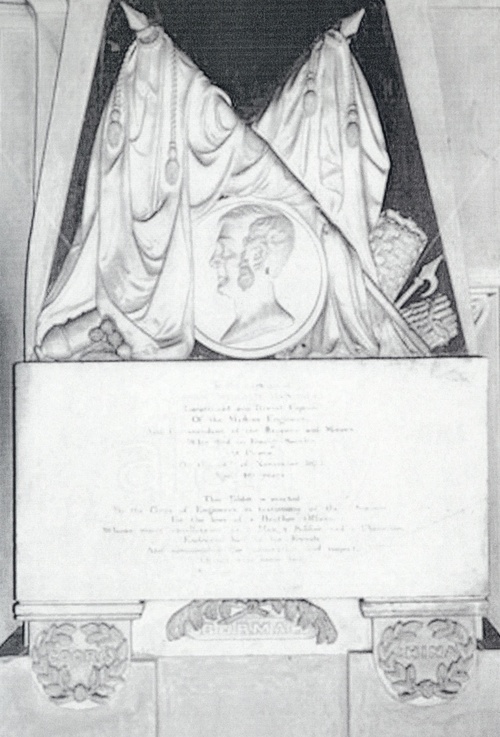Auction: 19001 - Orders, Decorations and Medals
Lot: 43
The important China 1842 Medal to 1st Lieutenant & Brevet Captain J. W. Rundall, Madras Sapper & Miners; twice mentioned in despatches and severely wounded at Canton, he received a further wound in the Pegu operations of 1852, later dying of disease at Prome
China 1842 (J. W. Rundall, 1st Lieut. Madras Sappers & Miners), fitted with a contemporary decorative straight-bar suspension with matching riband buckle and brooch-bar for wear, extremely fine
Provenance:
Ex-Tim Ash Collection.
John William Rundall was born at Madras on 29 September 1812, son of Lieutenant Charles Rundall of the 14th Madras Native Infantry. At a young age Rundall was sent to England for his education, where, in 1823, he is recorded at school in Essex, with his uncle, Thomas Wharton Rundall of Wanstead, as his guardian. In August 1828 he entered the East India Company's Military Seminary at Addiscombe, passing out from there in June 1830 aged seventeen years, recommended for the Engineers. Rundall returned to India after an absence of a decade or more to find that his father, then Lieutenant-Colonel, 32nd M.N.I., had died a few months before his arrival at Madras in December 1831. In January 1832 he was posted to the Madras Sappers and Miners.
In April 1834 Rundall experienced his first, and very short, spell of active service, in the Coorg Campaign. The Rajah of Coorg, a small Hindu principality with the capital Mecara at the head of the Western Ghats, was deposed for misrule and the State annexed to the Madras presidency. Rundall was deputed to search suspect places in the jungles of Coorg for the treasure buried by the ex-Rajah. His search, however, proved fruitless. The succeeding years passed peacefully and in September 1838 he was promoted to 1st Lieutenant. In 1839 Rundall suffered a serious illness which caused him to take several months of sick leave. However, he evidently made a good recovery as in General Orders, 1 April 1840, he was detailed with the Madras Sappers proceeding on 'services to the Eastward' - namely China.
Opium War - two mentions and a wound
Britain's relations with China had never been easy. Trade was restricted to the southern port of Canton and all communications with the government were in the hands of local Chinese merchants. Britain had no direct political representation at the Emperor's Court at Peking in the north, and all foreigners were considered 'barbarians.' During 1839 the British traders at their Canton Factories, where they existed under restrictive conditions, were forced to leave and an edict was published by the Chinese forbidding all trade with Britain. Various acts of aggression were carried out by the Chinese against British vessels, including those of the Royal Navy. It was against this backdrop that the first, or Opium, war with China took place. This war was mainly a naval expedition to which India supplied some 4,000 troops, but neither could have prevailed without the other. The greatest part of the military came from Madras and included 'A' and 'B' Companies of the Madras Sappers and Miners under Captain Pears.
The rendezvous for the Eastern Expedition, Singapore, was reached in early May 1840. At the end of the month the fleet sailed north and after blockading the mouth of the Canton River, or Bocca Tigris as it was also known, landed on the island of Chusan in Hangchow Bay, taking the capital, Tinghae, on 5 July. The troops remained at Tinghae for several months, living under most unhealthy conditions, whilst a diplomatic mission sailed north to the mouth of the Peiho River leading to Peking in the hope of resolving the dispute with the Emperor's government. In this they failed and were informed that any dispute between the two countries would be dealt with only by the authorities at Canton.
Leaving a garrison at Tinghae the expedition returned to the mouth of the Canton Estuary and on 7 January 1841 captured the two southernmost of the Bogue Forts, Chuenpi and Tycoktow, guarding the waterway to Canton. The Chinese then entered into negotiations: the island of Hong Kong was ceded to the British and Chusan returned to the Chinese. However, the negotiations failed and the further Bogue Forts of Annunghoy and North and South Wangtong Islands were assaulted and captured on 26 February. Rundall with 'A' Company, Madras Sappers and Miners, under Lieutenant W. J. Birdwood participated in the attack on the Wangtong Islands and received his first mention in despatches in the report of Major F. L. Pratt, 26th Cameronians, dated Bocca Tigris, 27 February, 1841, and published in the London Gazette on 11 June 1841:
'I must especially point out the services rendered by... Lieutenant Birdwood, Madras Engineers, who superintended the erections of the breastwork whilst Lieutenants Rundall and Johnston, Madras Engineers, accompanied me to lead the respective columns of attack.'
On 28 February, Rundall and Lieutenant J. G. Johnston were directed to demolish the Bogue Forts on Anunghoy with the assistance of working parties of seamen. Rundall was subsequently ordered to join a portion of the force that had proceeded higher up the Canton River. On 2 March Major-General Sir Hugh Gough arrived from Madras to assume command of all land forces, by order of the Governor-General of India.
Canton was a difficult city to approach, there were many navigational hazards particularly for the larger vessels of the fleet. However, Gough proceeded to advance his force, destroying defences along the river.
On the afternoon of 23 May a small force was landed at the Factories along the southern river face of the city and Gough proceeded up river to the village of Tsing-poo, his chosen place for landing the main force. Tsing-poo lay to the north and west of the city, from where the troops could advance to the heights overlooking the city to the south and east. His objective was an isolated hill just inside the northern wall of Canton from where he could dominate it. It was no easy task for Canton was well fortified with very high walls. By the evening of 26 May Gough's forces were poised ready for the final assault on the following morning. But it was not to be: political considerations took over with the result that Canton was ransomed and the Chinese Tartar garrison removed sixty miles away. Gough and his forces were greatly chagrined at this turn of events and the force was withdrawn over a period of days and returned to Hong Kong. Gough's despatch, 3 June 1841, to the Governor-General of India, describing the events in detail, comprised forty-five paragraphs. This despatch was published in the London Gazette Extraordinary, 8 October 1841, and in it Rundall received his second mention, at paragraph 43:
'To Captain Cotton, Field Engineer. I feel under the greatest obligation and I experienced the most ready support from every officer under him. Of one of them, Lieutenant Rundall, I regret to say that I shall probably lose the services for some time, in consequence of a severe wound. The useful labours of the Sappers called for my best thanks, they were cheerfully prepared to place the ladders for the escalade.'
Rundall being on the sick list for 'some time' was probably unable to participate in many of the succeeding engagements along the China coast and he next comes to note during Gough's final advance up the Yangtze River towards Nanking, at the battle of Chin-Keang-Foo on 21 July 1842. The town occupied a strategic point along the Yangtze as it was here that the Grand Canal crossed the river linking the north and south of the country as the main supply route. Chin-Keang-Foo was the hardest battle of the war: it was strongly defended by Tartar troops who fought to the death - first slaughtering their own families. Gough employed three brigades to attack it.
As there was a formidable wet ditch in front of the south and west faces of the city it was determined to force an entry for one of the brigades through the West Gate of the city. Captain T. T. Pears with Lieutenant J.W. Rundall were given this task. The gateway to be attacked was a very substantial work with a guard room above it and ramparts about twenty-eight feet in height. The gate itself consisted of two massive folding doors, ten feet high, seven feet wide and five inches thick, covered with sheets of iron. The gateway lay within an archway of a depth of six feet, thus affording adequate cover for the party placing the powder bags against the doors. Fortunately the city suburbs had extended beyond the gateway, thus giving good cover for the preparation of the powder bags as near as possible to the gate. Three bags were used, each fifty-eight pounds in weight, these were carried by three Sappers with the bags on their heads. In their hands they each carried a stick six feet long, notched at one end for the purpose of hanging the bag from it and propping it against the doors. The fuse was lit and in a few seconds the explosion took place, causing great clouds of dust and smoke. Whilst the archway itself remained undamaged the doors were completely blown in and lay some nineteen feet inside. The moment is dramatically captured in a watercolour by Edward H. Cree, a Royal Navy Surgeon.
Subsequent to the taking of Chin-Keang-Foo, Gough advanced up the Yangtze River to Nanking, where the force arrived on 9 August. The victory at Chin-Keang-Foo had proved decisive and three Imperial Commissioners were despatched by the Emperor to Nanking to treat with the British. On 29 August the Treaty of Nanking was signed, whereby the Emperor agreed to pay an indemnity of twenty-one million dollars and other concessions including the opening of five ports to trade.
The return of British units to India then began. 'A' and 'B' Companies of the Madras Sappers were awarded the battle honour China with Dragon, 30 October 1843. No Bengal or Bombay Sappers and Miners participated in this campaign and Rundall was one of eleven Madras Sappers and Miners officers to receive the China 1842 Medal.
By General Order dated 27 August 1844, Rundall was appointed to succeed Captain T. T. Pears as the fourth Commandant Madras Sappers and Miners. At thirty-two he was as yet unmarried, but taking leave in June 1845 to the Neilgherrie Hills, he married at Ootacamund on 10 June. His wife, aged twenty, was Miss Harriet Drury, the daughter of George Dominica Drury, a member of the Madras Civil Service. Over the succeeding years Emily gave him four children, two sons and two daughters. In 1846 the Madras Sappers and Miners under Rundall was reorganised and the Headquarters moved from Bangalore to Mecara, in Coorg.
Burma War - Commandant Madras Sapper & Miners - second wound and demise
The spring of 1852 brought the second war with Burma. The Burma Expeditionary Force of 5,800 men comprised two Brigades, one from Bengal, the other Madras, with Major-General H. Godwin in command. The Bengal Brigade arrived off the mouth of the Rangoon River on 2 April, then proceeded eastwards capturing Martaban on 5 April. Godwin then returned to the mouth of the Rangoon River where he was joined by the Madras Brigade on 8 April, including Captain Rundall and his Madras Sappers and Miners.
Godwin's next objective was Rangoon, much fortified since the first war of 1824. Godwin marched inland by a circuitous route to bring him opposite the eastern face of the Schwe Dagon Pagoda, the key to the position and now included within the defences of the town. First he had to take an outlying work known as the White House Stockade. This was accomplished by a storming party supported by two columns. They came under such heavy fire as they moved up that they were obliged to ground their ladders and return the fire. At the assault the Madras Sappers placed four ladders, one of which was raised by three Sappers after four of their comrades had been shot down in the attempt. Captain H. Fraser, Bengal Engineers, led the storming party followed by Captain Rundall. The stockade was taken, but not without considerable loss. During the assault Rundall saved Captain Fraser's life, killing a Burmese warrior who had overpowered him (Dobbs 1882).
On 14 April, Godwin continued his advance on the Schwe Dagon Pagoda. A storming party, under heavy fire, entered through a gate and captured the succession of terraces of the Pagoda. During this action Captain Rundall was wounded. With the Pagoda in British hands the defenders of Rangoon fled. Bassein was taken on 19 May, Pegu on 3 June and Prome on 10 October.
Rundall, however, died of liver disease at Prome on 12 December, aged forty. As he died, surrounded by his brother-officers, he uttered the words: 'Tell all I am very happy' (Dobbs 1882). Command of the Madras Sappers and Miners then devolved on Captain J. Carpendale. Rundall had held the post of Commandant for eight years, well in excess of any other Commandant up to 1857. An impressive marble memorial commemorates him at St. Mary's Church, Fort St. George, Madras, featuring his profile between two crossed flags. His wife, who survived him, died in England in early 1916, aged ninety.
Rundall heads the eighteen names of the officers of the Madras Sappers and Miners on the Medal Roll for the India General Service Medal (I.G.S.M.) with clasp 'Pegu'. He is noted as 'Commanding' and 'Deceased.' Had he lived he would have worn on his jacket his China Medal 1842 and I.G.S.M. for Pegu - a unique pair to an officer of the Corps of Madras Sappers & Miners; sold with a folder of copied research and London Gazette entries.
Reference works:
Captain Tim Ash M.B.E., 'John William Rundall, Madras Sappers & Miners 1812-52,' in The Journal of the Orders & Medals Research Society (Sept. 2005), pp. 183-187.
Major-General R. S. Dobbs, Reminiscences of Life in Mysore, South Africa, and Burmah (London, 1882).
Subject to 20% VAT on Buyer’s Premium. For more information please view Terms and Conditions for Buyers.
Sold for
£2,200











